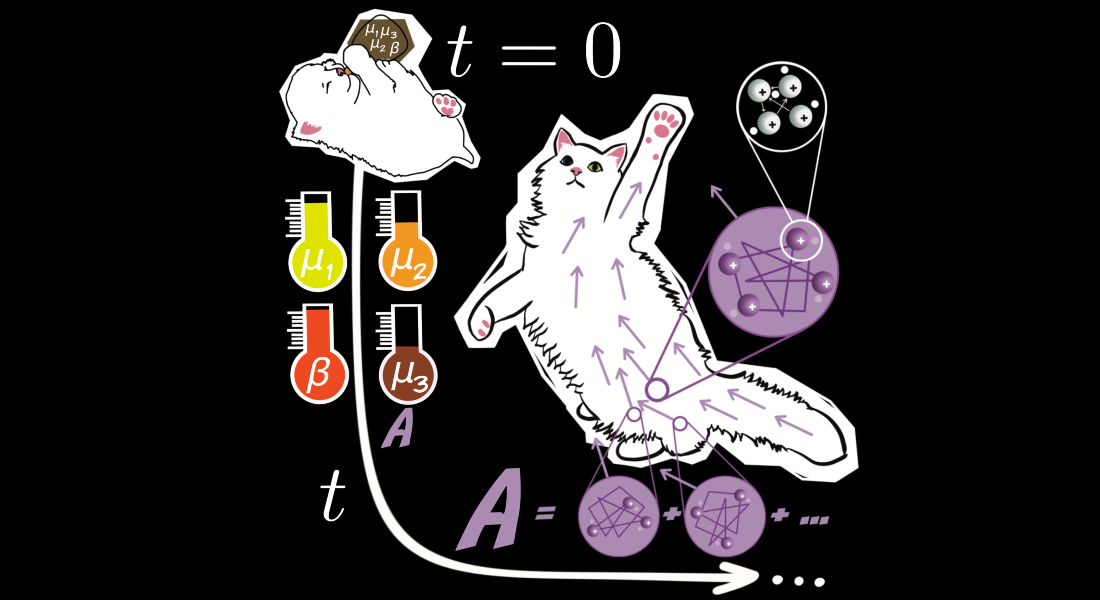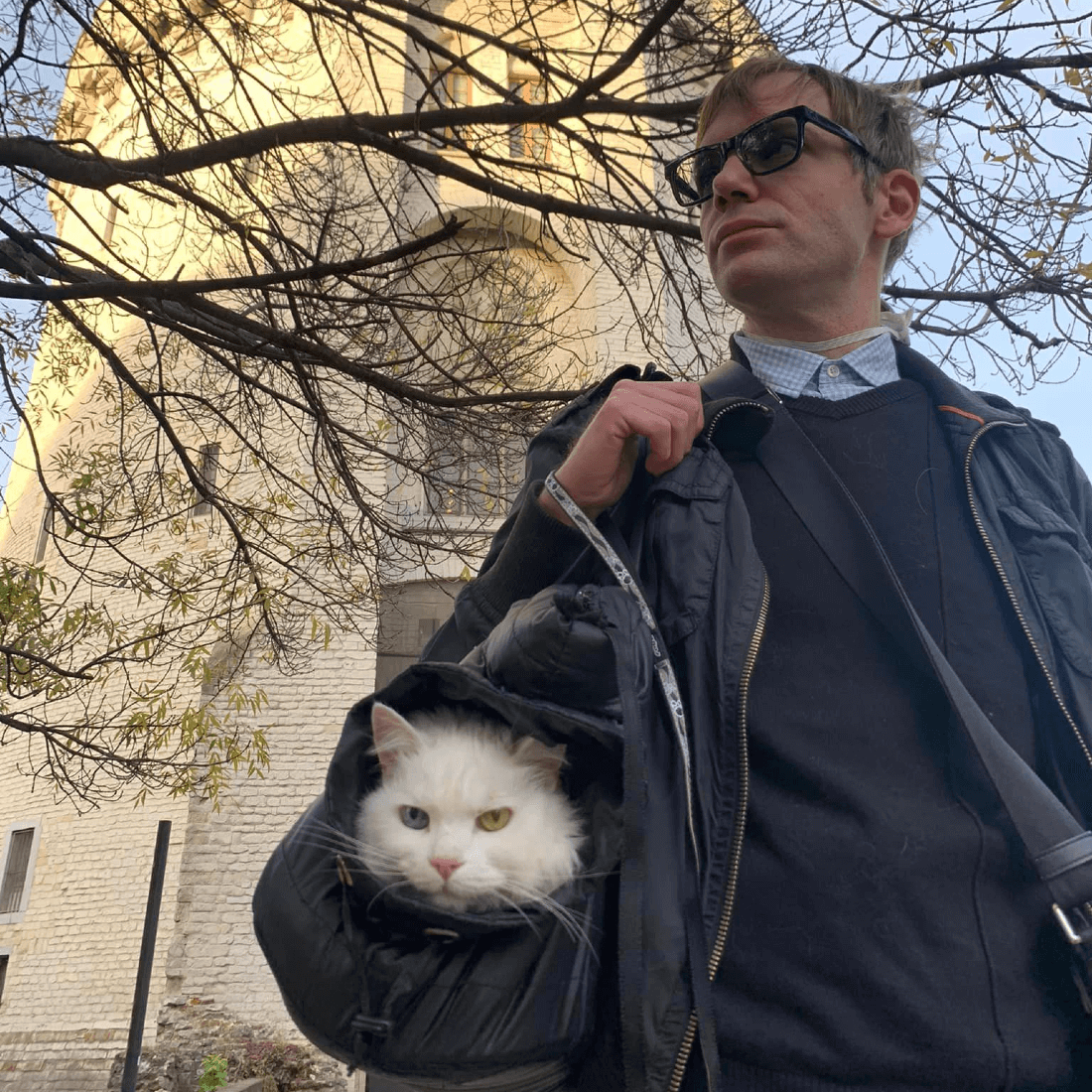A breakthrough in theoretical physics is an important step towards predicting the behavior of the fundamental matter of which our world is built. It can be used to calculate systems of enormous quantities of quantum particles, a feat thought impossible before. The University of Copenhagen research may prove of great importance for the design of quantum computers and could even be a map to superconductors that function at room-temperature.

On the fringes of theoretical physics, Berislav Buca investigates the nearly impossible by way of "exotic" mathematics. His latest theory is no exception. By making it possible to calculate the dynamics, i.e., movements and interactions, of systems with enormous quantities of quantum particles, it has delivered something that had been written off in physics. An impossibility made possible.
The unexpected presence of a white cat adorns the illustrations of Buca's research. Pulci the cat is his eye-catching muse. Arrows through the cat's body illustrate the quantum mechanical origin of the playful cat's movements - and this is precisely the relationship that Buca is trying to understand by making it possible to calculate the dynamics of the very smallest particles.

Not the first kitty on the front lines of physics
This is not the first time in the history of physics that a cat has stolen the limelight of a theoretical physics breakthrough. Schrödinger's famous cat in a box was both dead and alive at the same time in an analogy to superposition.
The relationship does not extend that far with Pulci, who at the considerable age of 17 years, is still going strong.
The breakthrough has reinvigorated an old and fundamental scientific question: Theoretically, if all behavior in the universe can be calculated by way of the laws of physics, can we then predict everything by calculating its smallest particles?
"Many physics disciplines are ultimately about explaining and predicting the world by understanding the laws of physics and calculating the behavior of the smallest particles. In principle, we would be able to answer any possible question about how all sorts of things behave if we were able to," says Berislav Buca of the University of Copenhagen's Niels Bohr Institute, who adds:
"In principle, the behavior of everything in the universe can be understood from the microscopic laws that govern particle dynamics," he says, while quickly appealing for caution.
"Of course I can't do that," chuckles the theorist.
A theoretical shortcut avoids the devil in the details
The interactions and movements of quantum particles in their systems are so complex, the researcher explains, that even the world's most powerful supercomputer today is only able to perform calculations on a dozen of these particles at a time.
At the same time, a single atom consists of at least two quantum particles, and a single grain of sand of about 50 billion times a billion atoms - not to mention a cat or anything else one would want to understand in our universe.
The new theory is able to answer how the dynamic develops into a broad class of systems, which interact locally, meaning that the forces between the particles, those that create movements, work at a relatively short distance.
Among Buca's next goals is the task of developing the theory to apply to all classes of quantum particle systems.
"So, in practice, it isn't possible. Not currently. However, my theory is a significant step in the right direction. This is because it takes a kind of mathematical shortcut to understanding the dynamics of the whole, without computing power being lost in the details for a broad class of systems with many quantum particles. That is, without the need to calculate all of the individual particles in a system," explains Berislav Buca.
The theory has already made a name for itself by providing the first mathematical proof of a long-held hypothesis in theoretical physics.
Up until now, the so-called eigenstate-thermalization hypothesis has been an assumption - an educated guess - in physics that had yet to be explained mathematically. It concerns the ability of mathematics to describe the motions of quantum systems as wholes.
Thus, Buca's theory has already demonstrated its value as basic theoretical research, and accomplished what theorists had long considered impossible. While the results mainly interest the bright minds of physics for now, the consequences could eventually be great for us all.
A compass for the quantum-mechanical treasure map
This knowledge could end up showing the way to sought for quantum materials with properties so unique that they could transform our world.
These quantum materials are a prerequisite for digging our claws into some of the greatest scientific "birds on the bush" - such as stable quantum computers or even superconductors that work at room temperature.
There is a growing demand for materials with unique electronic and magnetic properties that can be exploited in a variety of technologies, from superconductors to quantum computers.
Quantum physical properties play an important role in the behavior of these materials.
With them, the researchers expect to be able to design so-called "out-of-balance" phases, by way of the properties of these materials which would allow them to maintain such phases.
"We are looking for a material for quantum computers that can withstand entropy - a law of nature that causes complex systems - e.g., materials - to decay into less complex forms. Entropy destroys the coherence needed for quantum computers to be stable and keep working," Berislav Buca explains.
The exotic math systems that initially inspired him and made his research breakthrough possible may be just what a quantum computer needs to be truly useful.
"The so-called qubits that a quantum computer theoretically works with must be in a state of superposition to function, meaning that they are simultaneously turned on and off - in common phrasing. This requires them to be in a stable quantum state. However, thermodynamics does not like the structures required by the current materials. My theory may be able to inform us whether these exotic systems can be a way of structuring things so this quantum state could be more permanent," says Buca.
The method is a bit like a road map that can guide researchers across a vast landscape of possible materials by allowing for predictions of how these materials would behave under experimental conditions. For the first time, this gives researchers a way to target their search for quantum materials equipped with special properties.
"Until now, the hunt for these materials has been governed by chance. But my results can, for the first time, provide a guiding principle to navigate by when searching for unique properties in materials," says Berislav Buca.
Additional information:
First evidence of recognized hypothesis
The now proven hypothesis explains why Buca's math is able to accurately describe quantum systems, and explains how these systems move from a starting point of non-equilibrium to a state of thermal equilibrium over time.
It is a condition that is simple and in which the microscopic details no longer play a decisive role. And, where the system behaves as expected based upon the laws of thermodynamics.
"My theory is important for our understanding of thermodynamics because it demonstrates that these aberrant systems with many particles, which were previously considered out-of-equilibrium, are in fact always in a different time-dependent state of equilibrium," explains Buca.
Thermodynamics is a branch of physics in which fundamental scientific theories of heat and other forms of energy are formulated as laws.
- Systems will always try to achieve thermal equilibrium with each other. In everyday life, this includes the gradual cooling of a cup of coffee to the point where its temperature matches that of its surroundings.
- Conservation of Energy - Energy is neither created nor destroyed, it can only be converted. The heat in a coffee comes from somewhere and is not lost, it is simply transferred to its surroundings.
- Entropy - Any natural process will generally lead to increasing disorder or chaos in a system. Entropy is a measure of the disorder or unavailability of energy in a system. The heat in the coffee flows from the cup to its cooler surroundings, never the other way around.
- Absolute Zero - There is an absolute zero point of heat (-273.15 Celsius) where all particles stand still, but no upper limit.
Exotic exceptions confirm the rule
Buca's idea for the theory came while he was studying what are known as exotic algebraic structures and engaged in extreme mental math - mathematical quantities that are at the very edge of theoretical physics.
These mathematical structures can be used to understand systems of particles that challenge the laws of thermodynamics, which state that they will seek equilibrium in a simple, calm manner. Instead, it can go on endlessly, alternating between extremes.

"I wondered about these systems that apparently didn't follow the usual laws, that from a state of disorder eventually even out over time," says Berislav Buca.
One can imagine the meeting of two materials - one hot, one cold. Normally, as a result of the first and second laws of thermodynamics, heat will seek to equalize the thermal difference by moving the energy from the hot material into the cold - never back again. We encounter these laws every day without thinking about them, e.g. when pouring cold milk in a cup of hot coffee, or forgetting the bag of frozen peas on the kitchen counter.
In the exotic systems that Buca wracked his brain over, the movement goes in both directions and continues endlessly.
"I studied the systems mathematically and was able to find some structures that prevent the systems from equalizing, but lead them in a kind of constantly changing equilibrium overall. The aberrant systems showed me some external limits to these laws - as a kind of exception that confirms the rule. This is how I was able to complete my theory," he says.
About the study
Berislav Buca is the sole author of the research paper, which was published in the highly respected journal Physical Review X.
The research was funded by a Young Investigator Grant from the Villum Foundation.






